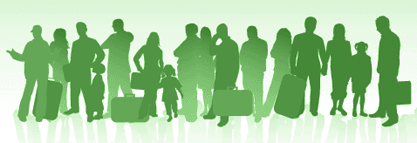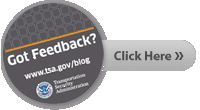BobHi, I'm Bob, and I started with the
TSA in September 2002. I worked at the Cincinnati-Northern Kentucky International Airport (
CVG) for 5 years and am currently residing at
TSA headquarters. I started as a Transportation Security Officer (
TSO), and have since been promoted to a Program Analyst with the Office of Strategic Communications and Public Affairs.
In my nearly 6 years with
TSA, I've also worked as an Operations Watch Officer, Instructor, Training Coordinator,
Behavior Detection Officer, and I served as the Vice Chairman on
TSA's first National Advisory Council - a group representing
TSA's frontline workforce in discussions with
TSA leadership on security and workplace issues.
I live in Northern Virginia with my wife, 4-year-old daughter, newborn daughter, and a 100 pound German shepherd named Clarence.
Prior to the
TSA I was a singer songwriter and traveled the world with my band. Songwriting is now one of my hobbies along with record collecting, ugly ties and photography. My favorite type of music is
pre-punk garage rock music from the 1960s.
JayHi, I'm Jay, and I started with the
TSA in June 2002 as a Federal Air Marshal and today I work as a Federal Security Director in the Midwest. Prior to beginning my career with the
TSA my field of expertise was law enforcement and business, however people might be surprised to know I was also a high school football coach and a Dean of Students.
I’m married and have two daughters and one son. My hobbies are spending all free time I have with my family and exercising.
LynnI’m Lynn, and I joined
TSA on September 11, 2006. It’s somewhat coincidental because on September 11, 2001, I was nine months pregnant, headed to work in DC and heard about the first plane hitting the
WTC as I was driving past the Pentagon. By the time I got to my office, the Pentagon had been hit. The image of dazed people crossing the highway and the smoke pouring out of the Pentagon as I drove home is still fresh in my mind. After my son was born, I spent the next five years as a full-time mom and got hooked on blogging. I also honed my skills in traveling with small children.
At
TSA, I manage information sharing efforts, work on Web 2.0 initiatives, collect data and stats, and provide incident management support. I’m an information junkie, participate regularly on various message boards and travel sites, and I’m a huge fan of the Darwin Awards and the DC City Paper’s News of the Weird, which makes me want to post regularly on the wacky things we see at
TSA on a regular basis.
NicoI'm Nico and I have been with the
TSA since just about the beginning, January 3, 2002 to be exact, 35 days after Congress created the agency. I currently manage public affairs for the agency in the Pacific region which includes California, Arizona and Hawaii, though I have served as the primary media
POC for as many as 16 states at one time or another.
I came to the
TSA after serving 10 active years in the Navy and am now a Navy Reserve officer with over 17 years in uniform. My wife served in the Navy for 10 years, my brother continues to serve, another brother served and my kids can't wait to serve. A Navy family some would say.
On September 11, I was scheduled to attend a meeting in the Pentagon, in the same corridor where the plane hit, though I avoided the meeting because I was watching television coverage of the World Trade Center. On that day it became clear that the world my children would grow up in is a significantly different world than the one we knew. Securing our homeland is certainly a passion for me.
PaulHello everyone, I’m Paul and I just arrived at the TSA fresh out of college. I have several years experience working with various types of news media, ranging from radio to magazines to online publications. I’m originally from Philadelphia—home of the *best* sports fans in the nation. Philadelphia Phillies 2008 World Champs.
For the past 8 years, I’ve spent countless hours rowing on the Schuylkill River in Philadelphia and the Charles River in Boston. Rowing competitively is one of the most satisfying experiences out there.
Labels: innovation, mission
 One of the requirements of the 9/11 Bill asked TSA to look at ways to enhance security by identifying airline flight deck crew members (pilots) and giving them a faster way to get through security.
One of the requirements of the 9/11 Bill asked TSA to look at ways to enhance security by identifying airline flight deck crew members (pilots) and giving them a faster way to get through security.






 At TSA we are piloting a variety of innovations at the checkpoint to improve security by focusing on people, technology and process.
At TSA we are piloting a variety of innovations at the checkpoint to improve security by focusing on people, technology and process.


